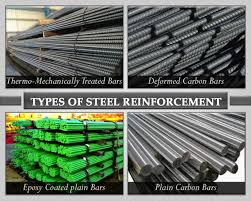Types of reinforcement steel in Construction
Hot rolled deformed bars:
Hot rolling is done in the mills which involves giving it deformations on the surface i.e. ribs so that it can form bond with concrete. The stress - strain curve shows a distinct yield point followed by a plastic stage in which strain increases without increase in stress. This is followed by a strain hardening stage. It has typical tensile yield strength of 60,000 psi.
Mild steel bars:
These are plain bars and have no ribs on them. These are used in small projects where economy is the real concern. As plain bars cannot bind very well with concrete hence hooks have to be provided at the ends. In this type of steel too stress - strain curve shows a distinct yield point followed by a plastic stage in which strain increases without increase in stress. This is followed by a strain hardening stage. Plastic stage in Mild Steel Bars is even more pronounced than Hot Rolled Deformed Bars. Typical tensile yield strength is 40,000 psi.
Prestressing steel:
Prestressing steel is used in the form of bars or tendons which are made up of multiple strands, however, tendons / strands are more frequently used as these can be laid in various profiles, which is a primary requirement of prestressing steel. Prestressing strands are, in turn, made up of multiple wires (typical 2, 3 or 7 wire strands).
Typical seven wire strand consists of six wires spun around the seventh wire which has a slightly larger diameter, thus forming a helical strand. These wires are cold drawn and have very high tensile ultimate strength (typically 250,000 - 270,000 psi). Their high tensile strength makes it possible to effectively prestress concrete even after undergoing short term and long term losses.
These are used in prestressed concrete in bridges or prestressed slabs in buildings. Prestressing steel is also available as non-bonded strands encased in PVC sheath. It is used in Post-Tensioning of members.
Prestressing strands are also available as Low Relaxation Strands which exhibit low relaxation losses after prestressing. These are typically used in prestressing members with large spans.
Cold worked steel reinforcement:
When hot rolled steel bar undergoes process of cold working, Cold worked reinforcement is produced. Cold working involves twisting or drawing the bars at room temperature. This effectively eliminates the Plastic Stage in the Stress-Strain curve, although it gives more control over the size and tolerances of bars. Due to removal of plastic stage it has lower ductility than Hot Rolled bars. Its use is specific to projects where low tolerances and straightness are a major concern. The stress – strain curve does not show a distinct yield point as plastic stage is entirely eliminated. Yield point is determined by drawing a line parallel to the Tangent Modulus at 0.2% strain. Yield stress is the point where this line intersects the stress – strain curve. This is known as 0.2% proof stress. If yield stress is determined at 0.1% strain it is called 0.1% proof stress. Typical tensile yield strength is 60,000 psi.





![Construction material | building material [ chapter 2]](https://blogger.googleusercontent.com/img/b/R29vZ2xl/AVvXsEgFNnWWces5dlM_2_KrVgml4IrHjhrLlSsZIIH4yzuQVU2KgtqeD2RKnLgYTe9WvfESgT2zMlkVmQ9A8bc3HtGMbpcpUUxNWwIIncET_5jjXVWzc2dgn2nnWc2tNYZjzekNOqbv_x5HNHIW/w100/download+%25288%2529.jpg)
![Construction material | building material [ chapter 1]](https://blogger.googleusercontent.com/img/b/R29vZ2xl/AVvXsEgVPDKSDjM5InicGASZAre8UdJL_Ai0XKVjl92syUFkj65uKC2cq8e8YCfzkscc8GVrH_2hvtmvLp1sILn0l4hwAc_VdwycZV51oV-n75odLMk0zdh-BzAzX7NIXX0OtQzZQBdJaVKfeKJQ/w100/download+%25284%2529.jpg)



0 Comments